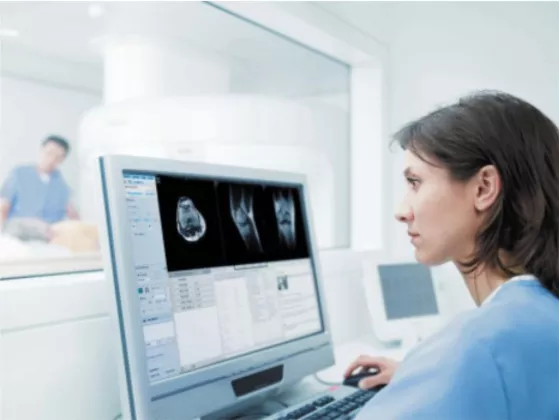Prioritizing patient comfort and satisfaction may be a hot topic among policy makers in today’s healthcare environment, but it’s nothing new for the healthcare providers who spend most of their time working directly with them. Radiology technologists like me have always known the vital role of a positive patient experience in creating clinical value for patients. In my role supervising MRI technologists at Phoenix Children’s Hospital, I’m made aware every day of the importance of providing a calming, supportive environment for our young patients and their families.
I’m also acutely conscious of the prominent role our staff plays in creating this calming environment. Whether it’s answering questions and addressing concerns prior to an exam or coaxing a nervous patient into the scanner, technologists are on the front lines of guiding patients and their families through what can amount to a very stressful situation. After all, we are the only human element standing between them and the loud, intimidating machine that may deliver life-changing information about their health.
Between our efforts to get patient images right the first time and manage our countless administrative duties, it’s easy to overlook the essential role that our experience can have on how the patient views their exam and subsequent treatment. When staff are preoccupied by the complexity of image acquisition, stressed by an overwhelming workload, or distracted by reporting tasks, it’s the patient who’s at risk for coming up short. To improve the patient’s overall experience within the imaging suite and beyond, we must do a better job of reducing the pressure on the radiology team.
As a veteran in the field, I often reflect on the extensive demands technologists must comply with in our current healthcare environment. Effectively managing patient throughput has always been a challenge for technologists, but today we face even greater pressure to serve as many people as possible, putting personalized care at risk. We also face unprecedented technical complexity. The need to stay up-to-date on the latest technology while acquiring the right diagnostic-quality images in a timely manner and delivering a positive patient experience – all takes place in an environment that emphasizes volume and often struggles to provide ample resources and staff.
The stresses caused by heavy workloads and overtime hours greatly contribute to burnout among radiology technologists, not to mention long-term mental and physical health issues.1 Additionally, human error resulting from overwork and burnout, which leads to mandatory overtime and inadequate sleep, is a main cause of medical errors in radiology, according to the American Society of Radiologic Technologists.2 Knowing that the experience of the imaging staff directly correlates with the experience of our patients makes it more important than ever that we expend the resources to ensure radiologists and technologists are adequately supported.
Any source of stress in the imaging suite affects the quality of the patient-staff dynamic. Beyond the technical errors that can be caused by an overwrought staff, patients can be impacted when they sense the technologist is stressed. I remember, for example, when I was tasked with putting my first pregnant patient into the MRI scanner for a fetal scan; it was clear that my lack of confidence translated to a sense of unease and apprehension for her. A calm technologist, on the other hand, is better able to help patients relax and hold still, an important factor in mitigating motion artifacts. Realizing how our attitude and state of mind effects patients has made me appreciate that it’s not just what we do each day that makes a difference: it’s how we do it.
New technology designed to distract and calm the patient makes the technologist’s job easier. I’ve been particularly excited to learn about new patient-centric advances, such as Philips’ Ambient Experience MR In-Bore Solution, which provides patients with a calming, positive distraction throughout their scan experience, making them more likely to hold still while in the scanner. This intervention, in addition to providing a kinder, gentler patient experience, has also been shown to reduce the need for rescans.3
On the subject of direct support for technologists, ‘smart’ clinical applications can eliminate some of the stress of image planning. Philips SmartExam, for example, assists in delivering reproducible planning results in more than 80% of procedures by using intelligent software that automatically plans the scanning geometries, based on validated scanning preferences.4 Not only does this make my job easier – it also increases my confidence in the scan results and allows me to focus more attention on the patient. And isn’t that why we chose this field in the first place?
There’s a saying in our field: “Happy patient, happy staff” (and vice versa!). We all know it’s true, yet the wisdom of this simple ideology often gets lost in the shuffle. When technologists are equipped with tools that empower us to guide patients through a calm and successful procedure, we are more likely to provide our radiologists the images they need; our administrators, the efficiency they desire; and our patients, the comfort and care they deserve.
To get a closer look at Phoenix Children’s Hospital’s patient-centered Radiology service, visit www.phoenixchildrens.org.
For more information on Philips’s patient- and staff-centered imaging solutions, visit www.philips.com/radiology.
References:
1. Vinu, Raj. Occupational stress and Radiography. NCBI. Nov-Dec 2006. https://www.ncbi.nlm.nih.gov/pubmed/17119177.
2. American Society of Radiologic Technologists (ASRT). Stress management for the radiologic technologist. Radiologic Technology 2012.
3. Andre, Jalal. Johanssan, Katarina. Relaxed patients, reduced motion, improved productivity. Fieldstrength MRI Magazine. http://www.usa.philips.com/healthcare/education-resources/publications/fieldstrength/mri-patient-experience-to-help-reduce-motion.
4. SmartExam is not available to patients with MR Conditional implants.
